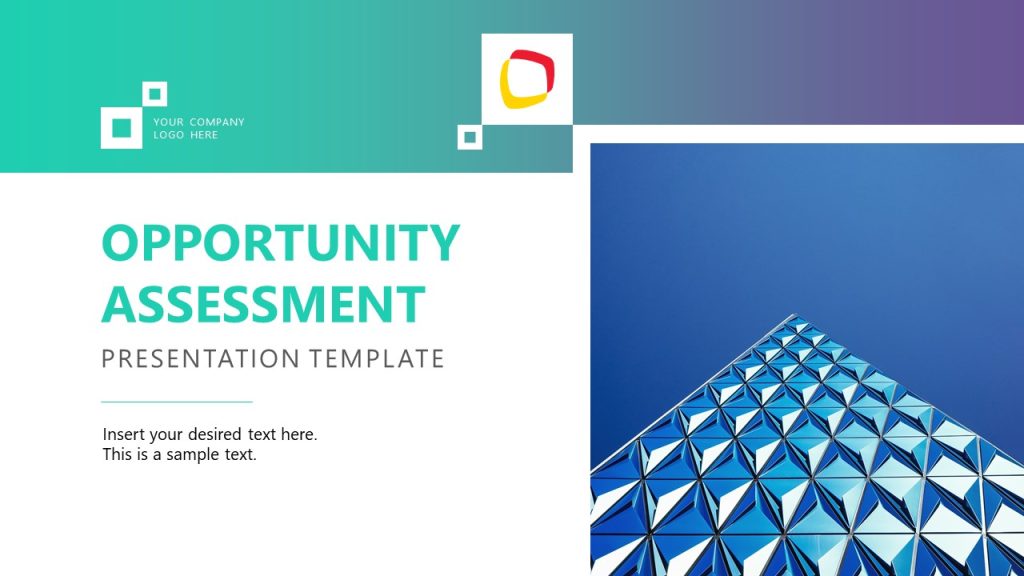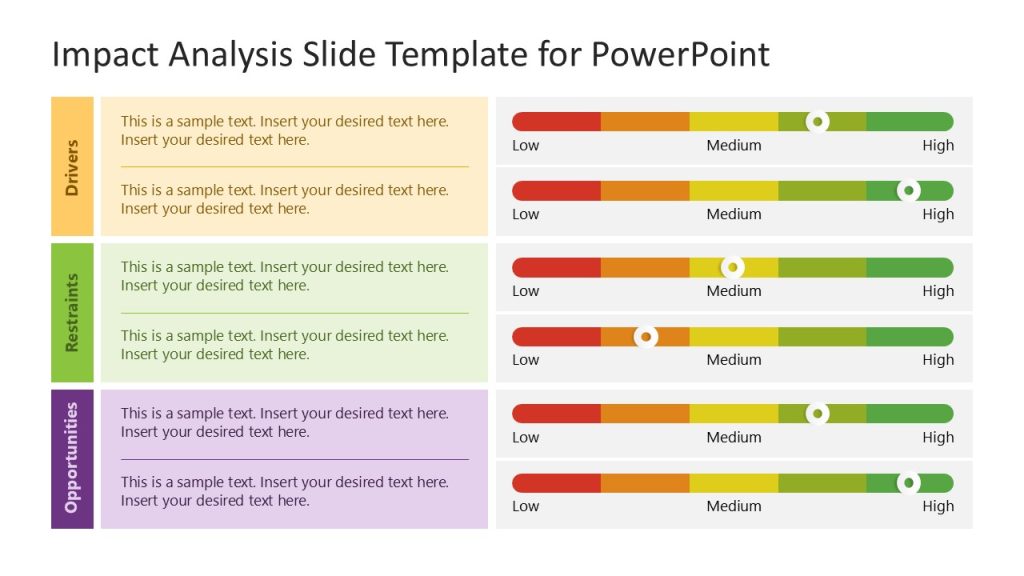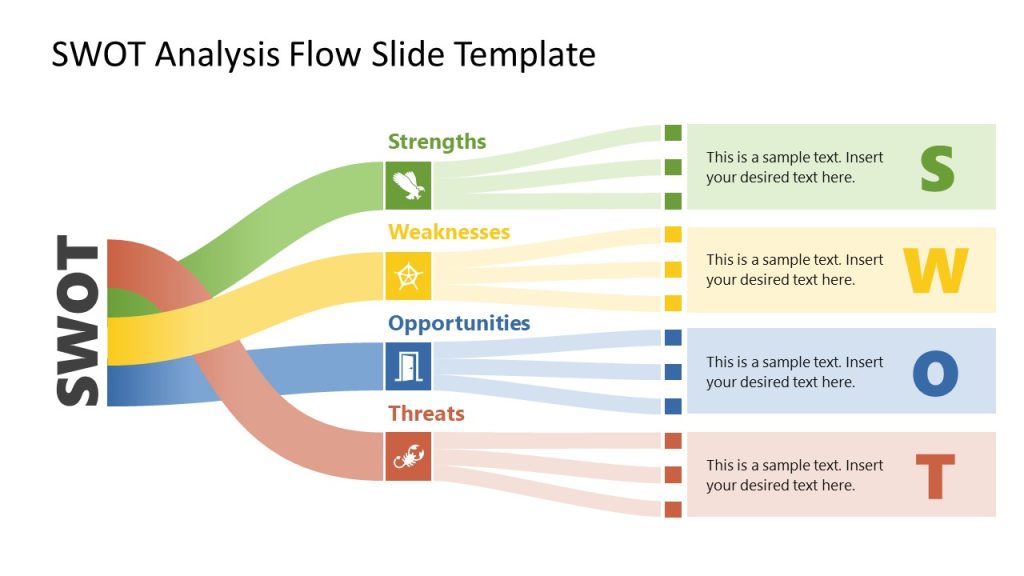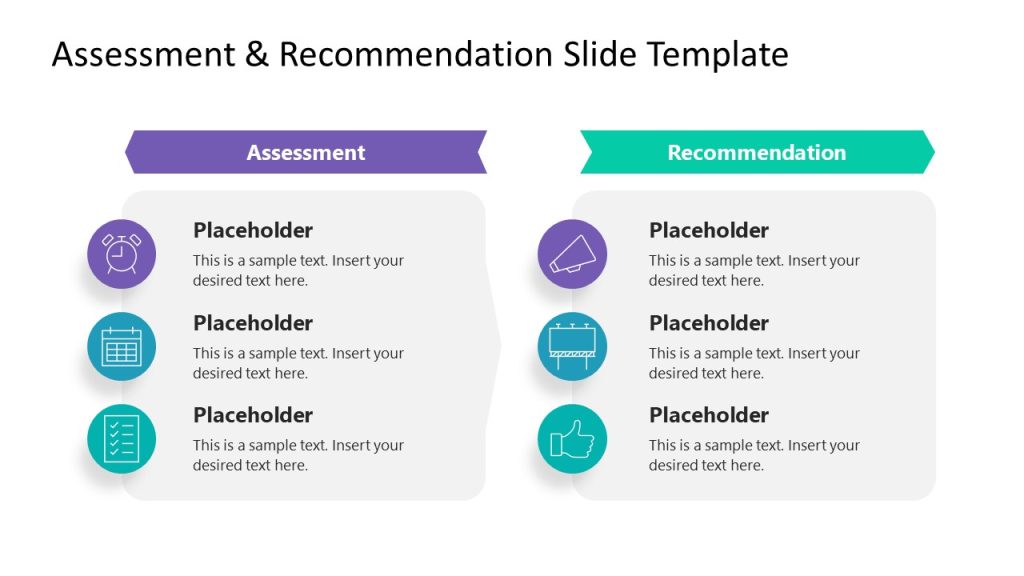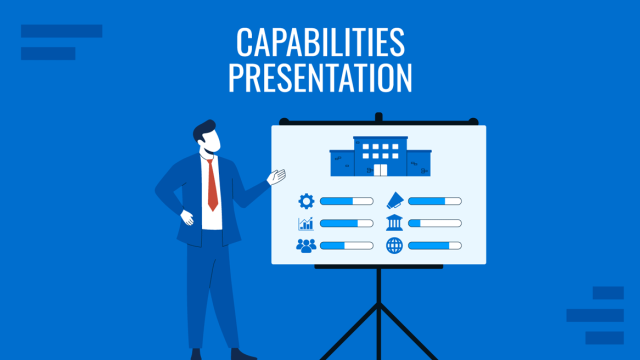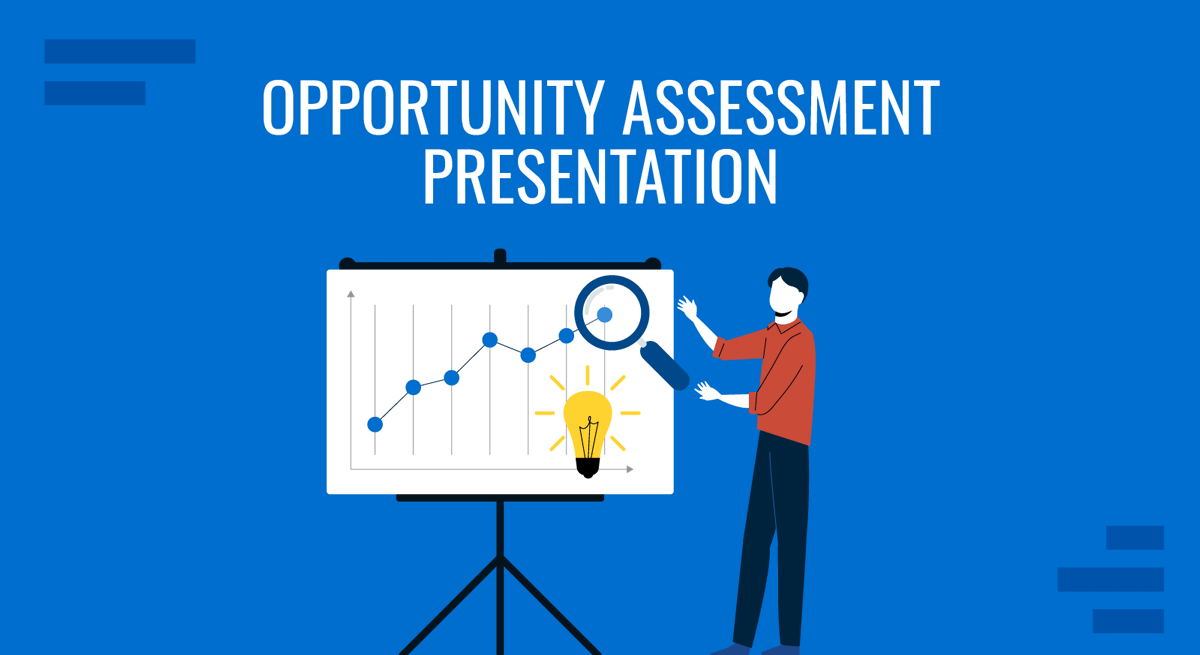
Whenever we need to bridge data analysis and strategic decision-making, opportunity assessments distill complex evaluations. Exposing whether they involve new markets, operational efficiencies, or procurement strategies, opportunity assessment presentations act as a concise, persuasive presentation format to guide stakeholders toward informed choices.
This article will cover in detail the process of crafting an opportunity assessment deck from either report data or an opportunity assessment plan document. At the end, you can find our selection of recommended PPT templates to speed up the design process.
Table of Contents
- What is an Opportunity Assessment Presentation?
- Importance of an Opportunity Assessment Presentation
- Components of the Opportunity Assessment Slide Deck
- Common Mistakes in Opportunity Assessment Presentations
- FAQs
- Recommended Opportunity Assessment PPT Templates
What is an Opportunity Assessment Presentation?
An opportunity assessment presentation is a framework used to evaluate and communicate the potential of a business opportunity to key stakeholders. It combines the findings of an in-depth opportunity assessment and organizes them into a coherent narrative that guides decision-making. The presentation analyzes key aspects such as market conditions, consumer needs, competition, and financial feasibility. Its purpose is to provide stakeholders with a comprehensive understanding of the opportunity’s potential risks and rewards while ensuring alignment with strategic objectives.
At its core, an opportunity assessment presentation is not merely a data collection but a persuasive narrative built on analysis. It incorporates both qualitative and quantitative insights to demonstrate the opportunity’s viability and scalability. It may also include a procurement opportunity assessment to explore cost-saving or resource optimization potential within an organization’s supply chain.
It is similar in structure to a business plan presentation but is more focused on analyzing a specific opportunity rather than outlining the overall operations and strategy of an entire business. While a business plan presentation provides a comprehensive view of a company’s objectives, strategies, and financial projections, an opportunity assessment presentation relies on evaluating a single initiative or market possibility, often serving as a precursor to developing a full business plan.
Importance of an Opportunity Assessment Presentation
The importance of an opportunity assessment presentation lies in its ability to drive informed decision-making. Without a structured evaluation, businesses risk allocating resources to initiatives without a clear investment return or strategic value. This presentation helps identify assessment opportunities early in decision-making, mitigating risks and ensuring alignment with organizational goals.
A well-executed presentation also builds stakeholder confidence. By outlining the opportunity assessment plan, the presentation demonstrates a thorough and methodical evaluation process. This approach ensures stakeholders understand the scope of the opportunity, the associated challenges, and the potential outcomes. Additionally, for procurement-specific initiatives, a procurement opportunity assessment within the presentation can identify ways to optimize supply chain efficiency or reduce costs, adding measurable value to the organization.
The opportunity assessment presentation is a persuasive tool in high-stakes scenarios, such as pitching to investors or seeking executive buy-in. It combines data-backed insights with strategic recommendations, enabling stakeholders to make decisions grounded in evidence rather than assumptions.
Components of the Opportunity Assessment Slide Deck
Market Overview
The market overview in an opportunity assessment presentation sets the foundation by providing stakeholders with a clear understanding of the industry and its current state. It includes an analysis of market trends, growth rates, customer demand, and external factors influencing the industry. This section demonstrates why the opportunity exists and highlights the broader context in which the proposed solution operates. By examining the total addressable market (TAM), the market overview defines the scope of the potential opportunity and its relevance to the organization’s strategic objectives.
An effective market overview often incorporates quantitative data, such as market size and projected growth rates, and qualitative insights, such as emerging trends and shifting consumer behaviors. It also considers macroeconomic factors, including regulatory changes, technological advancements, and global events that could impact the market dynamics. For example, the rise of sustainability in consumer preferences may present a unique opportunity for environmentally conscious products.
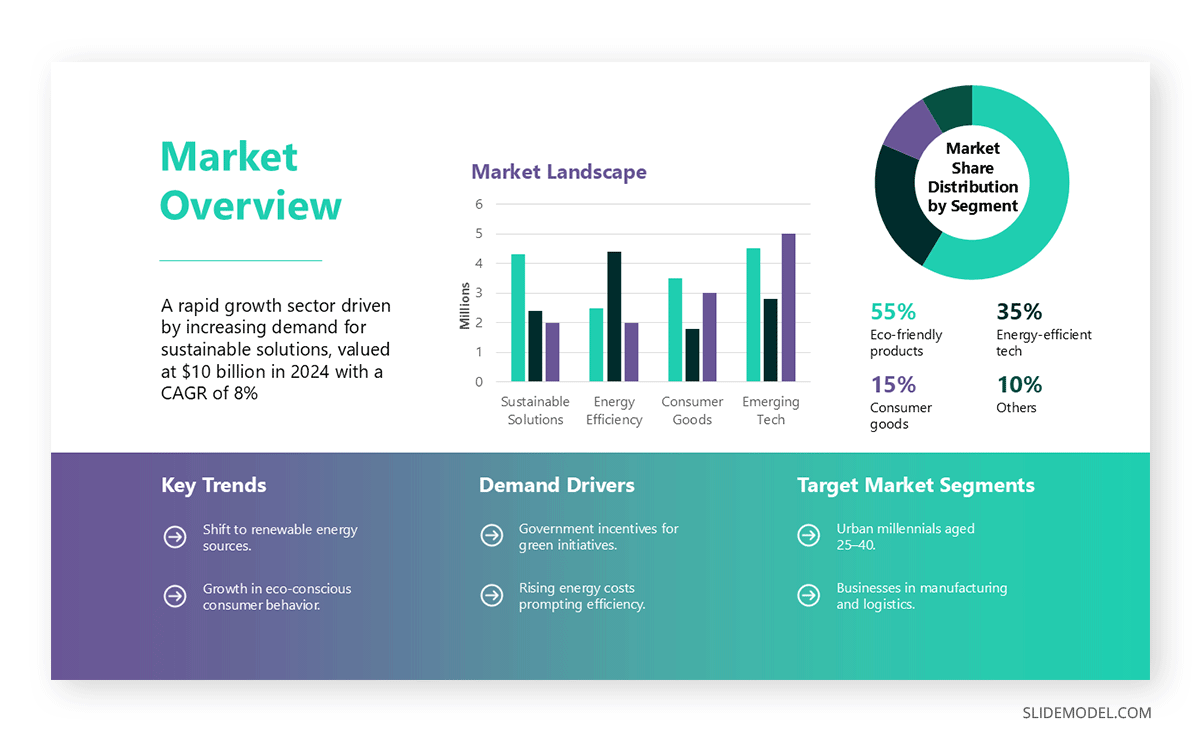
This section also identifies key market drivers and barriers. Drivers, such as increasing demand or technological innovation, highlight the factors pushing the market forward, while barriers, such as high competition or economic downturns, provide a realistic view of potential challenges. A procurement opportunity assessment may include market trends in supplier behavior or cost fluctuations, which could affect procurement decisions.
Problem Statement
The problem statement is one of the most critical sections in an opportunity assessment presentation because it justifies the need for the proposed solution. It clearly defines the specific issue or gap in the market that the opportunity addresses. By articulating the problem compellingly and concisely, this section sets the stage for the proposed solution and demonstrates why the opportunity deserves attention.
Data and evidence back a strong problem statement. They identify pain points faced by consumers, businesses, or stakeholders and illustrate the impact of these issues. For instance, in a procurement opportunity assessment, the problem statement might highlight inefficiencies in the supply chain or rising costs due to outdated procurement practices. The presentation emphasizes the urgency and importance of addressing the issue by quantifying it—for example, “50% of consumers report dissatisfaction with existing solutions.”
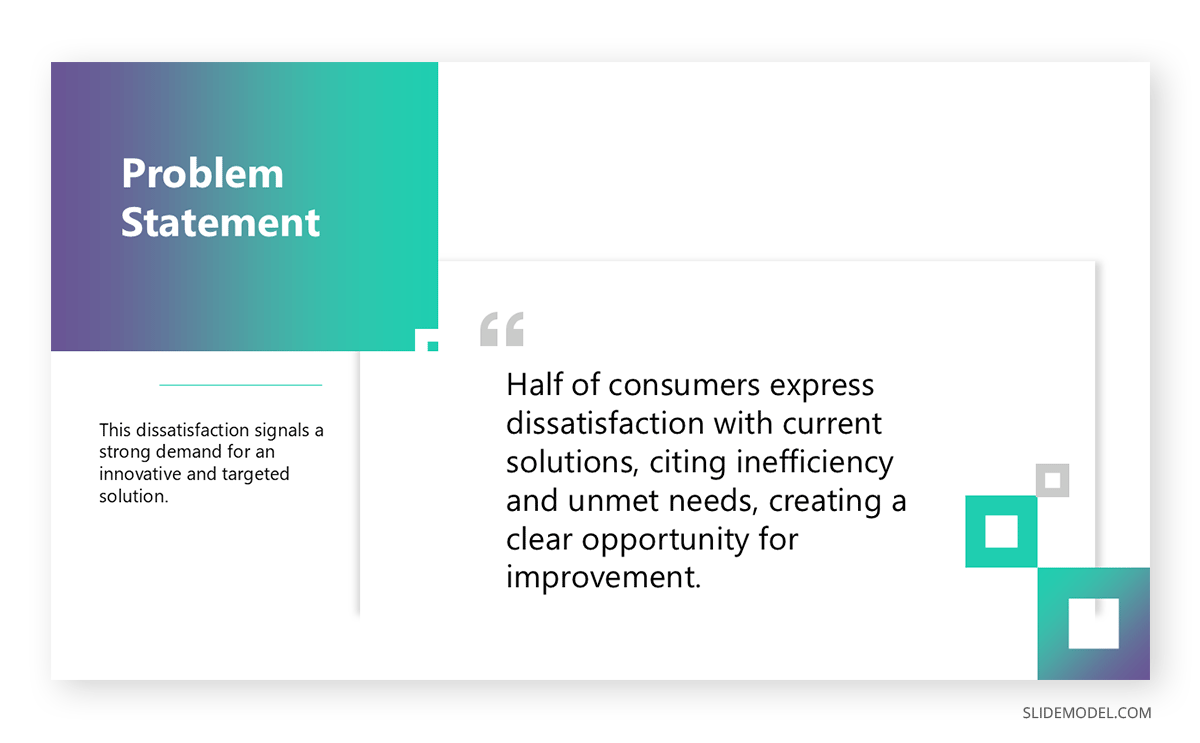
The problem statement should also consider the broader implications of leaving the problem unresolved. These could include financial losses, declining market share, or customer attrition. For example, if the target market is underserved due to a lack of innovative products, the problem statement could focus on the risks of competitors filling that gap if the opportunity is not pursued.
Consumer Analysis
The consumer analysis in an opportunity assessment presentation provides a detailed examination of the target audience, offering insights into their behaviors, preferences, and pain points. This section ensures that the proposed opportunity aligns with the market’s needs and is positioned to address consumer demands effectively. By diving into the audience’s demographic, psychographic, and behavioral aspects, the consumer analysis establishes a clear connection between the opportunity and its potential users.
This section typically begins by defining the target market segments. For instance, if the opportunity targets millennial consumers, the presentation would include data on their purchasing habits, preferences for convenience, and affinity for digital solutions. Buyer personas often bring these segments to life, providing a relatable and vivid depiction of the target audience.
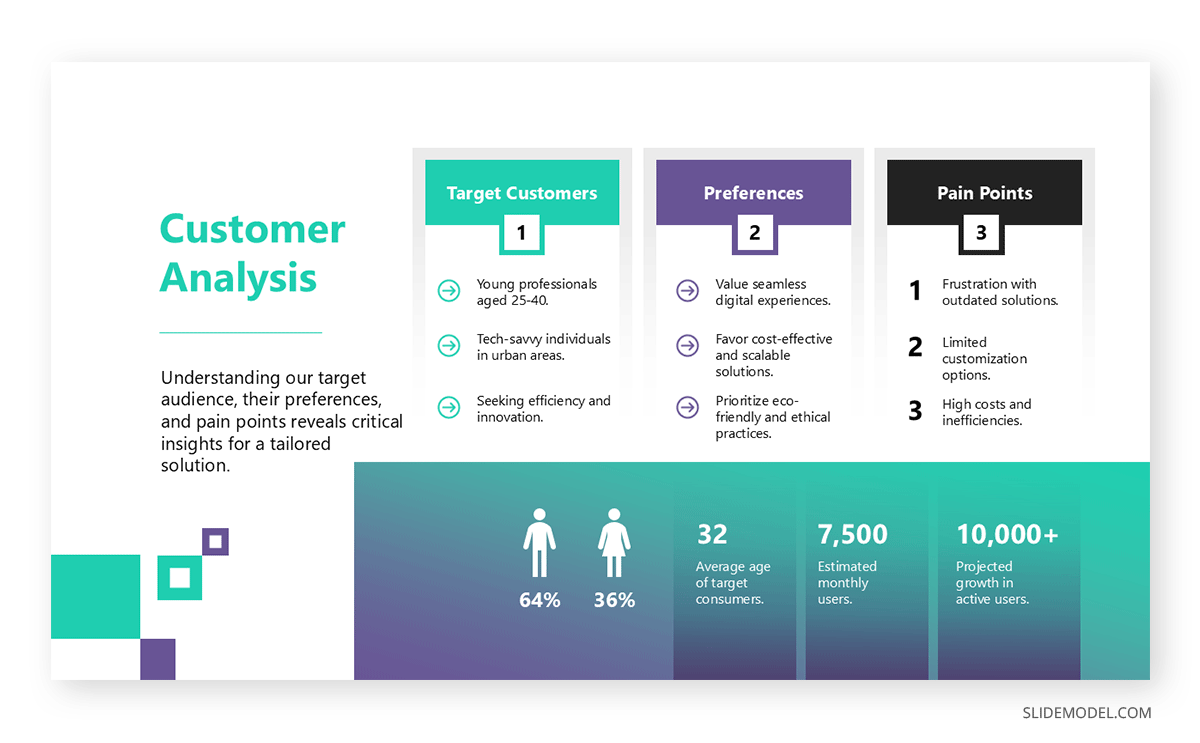
Quantitative data, such as survey results or purchase history, is essential in this section. For example, an assessment of opportunities in the e-commerce space might reveal that 70% of consumers prioritize same-day delivery. These insights help stakeholders understand the specific attributes the proposed solution must address to succeed.
Consumer analysis also identifies unmet needs or frustrations within the target audience. This builds the case for the proposed solution by demonstrating how it resolves these issues. For example, if existing products lack affordability or sustainability, the proposed opportunity could focus on these aspects as its competitive edge.
Competitor Analysis
This stage of the opportunity assessment presentation allows the organization to evaluate the competitive landscape and position the proposed solution relative to existing players. The competitor analysis helps demonstrate an understanding of the market dynamics, highlighting competitors’ strengths and weaknesses and the unique value of the proposed opportunity.
Start the competitor analysis by identifying the key players in the market. These may include direct competitors offering similar solutions or indirect competitors addressing the same customer needs through different means. For instance, competitors in a procurement opportunity assessment could include firms offering advanced procurement software or alternative cost-saving solutions.
Work with a side-by-side comparison chart based on pricing, product features, customer satisfaction, and market share. Visual tools like SWOT analysis (Strengths, Weaknesses, Opportunities, and Threats) analysis or competitive matrices are commonly used to illustrate these comparisons. Such tools help stakeholders quickly grasp where the proposed solution stands out.
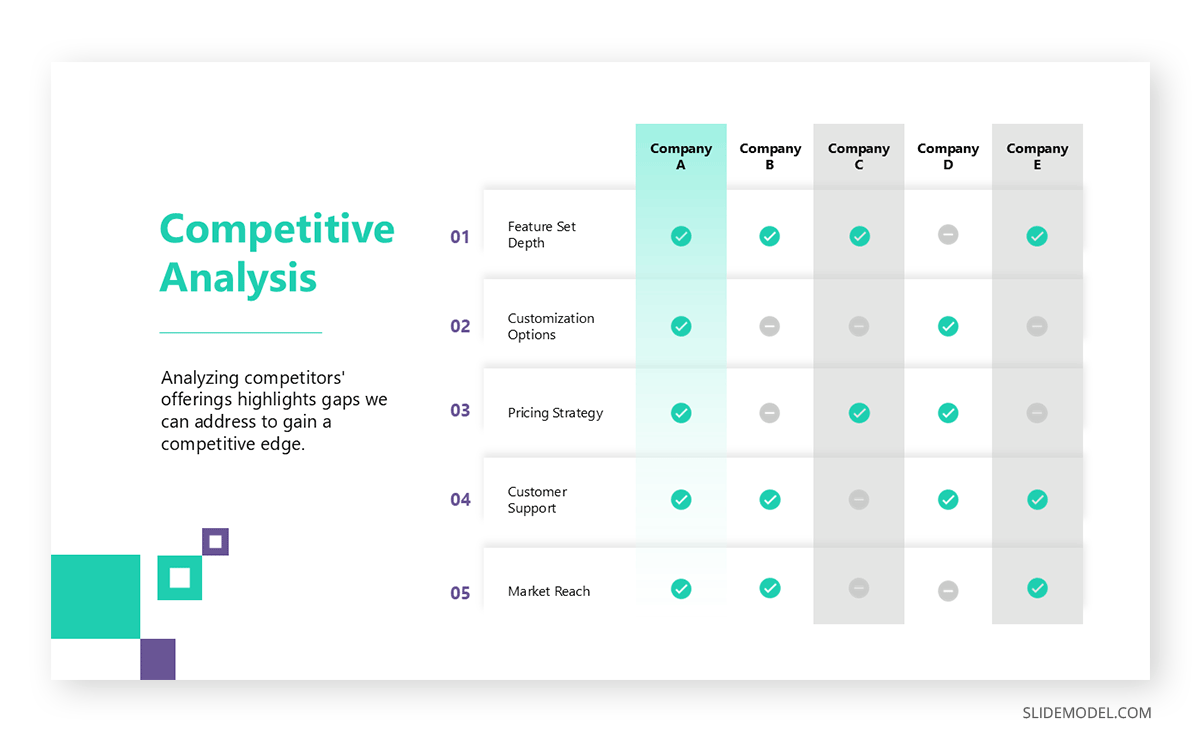
Understanding competitors’ weaknesses is equally important. If the analysis reveals gaps, such as poor customer service or limited innovation, these can be leveraged as opportunities for differentiation. For example, if competitors lack customization, the proposed solution could emphasize its adaptability to customer needs.
Solution Proposal
The solution proposal is the centerpiece of the opportunity assessment presentation, where the proposed idea, product, or service is described in detail. This section bridges the problem statement and the market opportunity, explaining precisely how the opportunity addresses the identified pain points and meets the target audience’s needs. The solution proposal is where stakeholders can begin to see the tangible benefits of pursuing the opportunity.
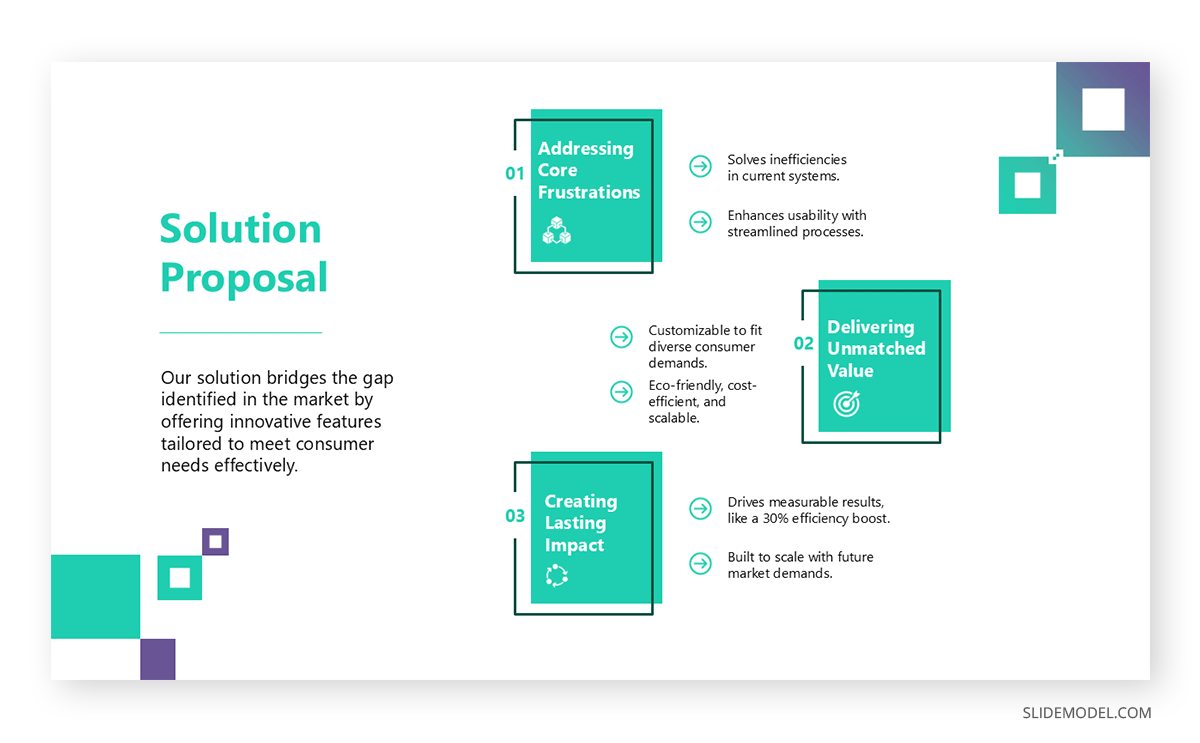
A well-crafted solution proposal clearly defines the offering, how it works, and the unique advantages it provides. For example, if the opportunity involves developing a procurement platform, the solution proposal would outline the platform’s features, such as AI-driven supplier recommendations, cost analysis tools, and real-time tracking of procurement activities. This section highlights how the solution will deliver value by focusing on functionality and practical application, hence its connection with the value proposition.
The solution proposal should also include evidence of feasibility. This could involve proof of concept, early prototypes, or test results demonstrating how the solution effectively addresses the problem. For example, presenting the results can build stakeholder confidence if the proposed solution has already been tested with a small target audience segment.
This solution proposal should differentiate the solution from competitors. By emphasizing features, benefits, or innovations unique to the proposal, the presentation makes a stronger case for why stakeholders should invest time and resources into this specific opportunity. For instance, these should be highlighted if the solution integrates advanced technology or offers a cost advantage.
Value Proposition
In general, the value proposition answers a fundamental question: Why should stakeholders invest in this opportunity? The value proposition demonstrates the strategic merit of pursuing the opportunity by articulating the distinct value that the solution provides to consumers, businesses, or other stakeholders.
A strong value proposition clearly defines the specific advantages the solution offers. For example, it may highlight how the solution saves time, reduces costs, improves efficiency, or provides a superior user experience. If the opportunity involves a procurement platform, the value proposition might emphasize benefits such as streamlined supplier negotiations, better cost forecasting, and real-time procurement tracking.
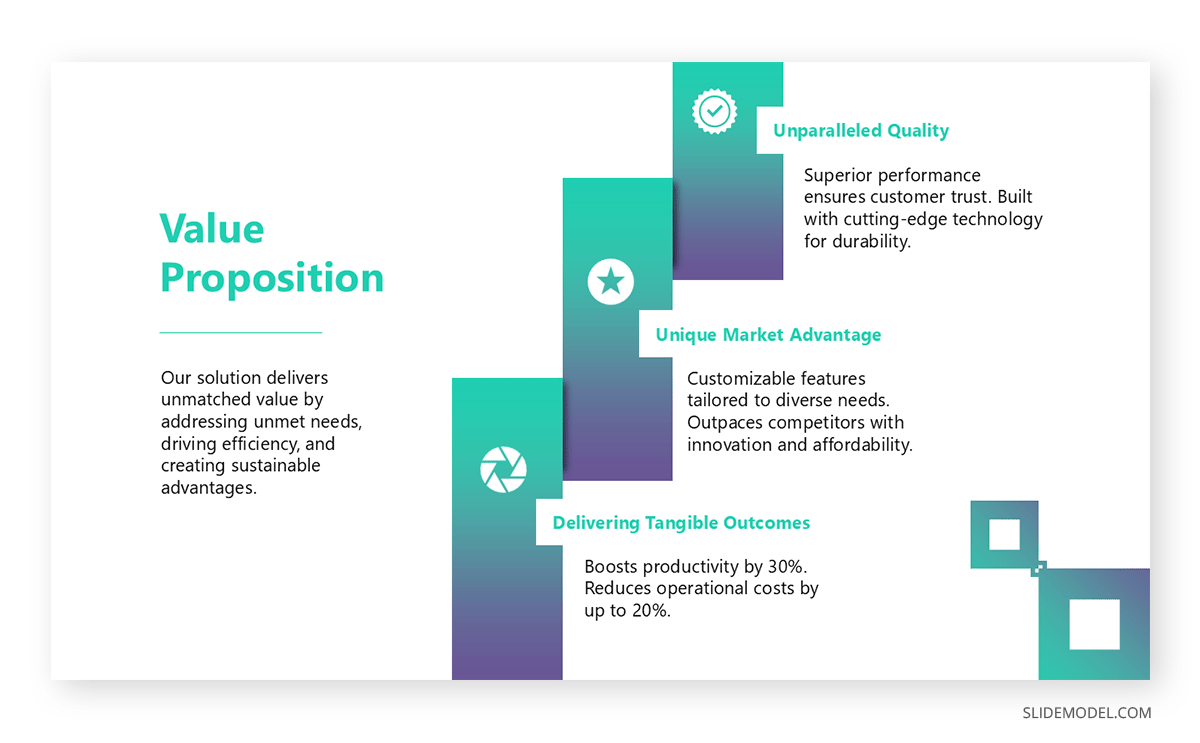
Also, the value proposition should focus on differentiation. In a competitive market, providing value is not enough; the solution must stand out from existing offerings. The value proposition solidifies its appeal by addressing how the opportunity improves upon competitors’ weaknesses or offers something unique.
Potential Revenue
Potential revenue is the section where stakeholders get a grasp of the financial gains that can be expected from pursuing the opportunity. Income forecasts allow stakeholders to evaluate profitability, scalability, and alignment with the organization’s financial goals. It is one of the sections most scrutinized by stakeholders, particularly investors, and decision-makers, as it directly impacts the perceived feasibility of the opportunity.
Revenue projections should be based on comprehensive market research and realistic assumptions. This involves analyzing market size, expected market penetration, pricing strategy, and consumer demand. For example, in a procurement opportunity assessment, potential revenue could include savings achieved through optimized procurement processes or increased efficiency across supply chains.
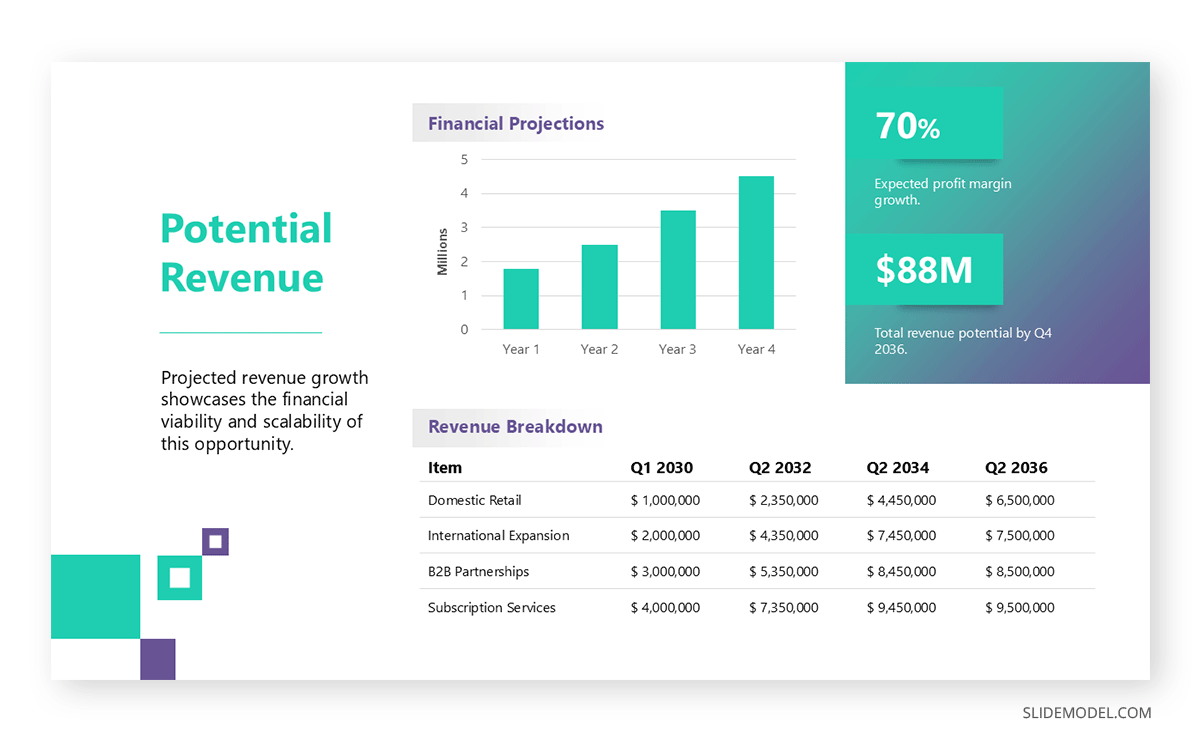
A well-developed revenue forecast often includes different scenarios, such as conservative, moderate, and optimistic projections. The presentation demonstrates a balanced approach and builds credibility by presenting a range of outcomes. You can find more insights in our guide on financial presentations for this type of slide.
Cost Structure and Resource Needs
A thorough cost structure analysis breaks down expenses into development, production, marketing, distribution, and operational costs. For example, costs in a procurement opportunity assessment include software development, employee training, and supplier onboarding fees. Each cost should be clearly defined and, where possible, supported by research or estimates to enhance credibility.
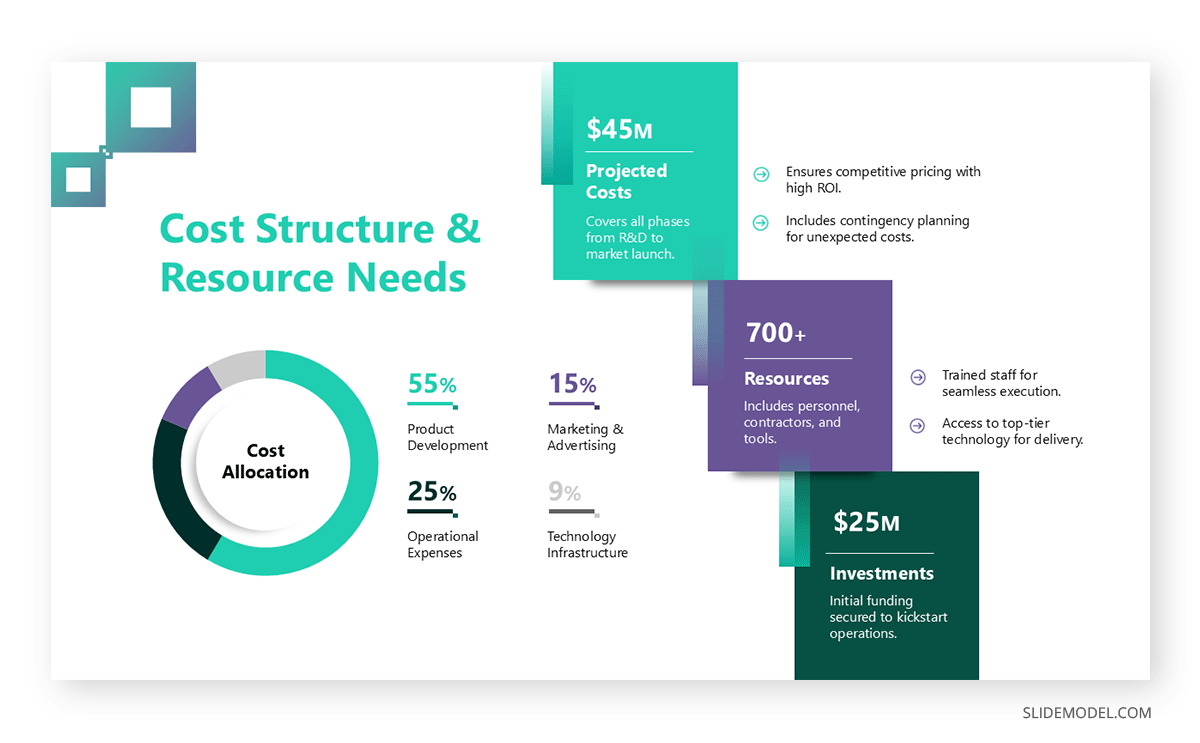
This section addresses resource needs, including human capital, technology, and infrastructure, in addition to monetary costs. For instance, if the opportunity requires a development team, the presentation should outline the number of personnel, their roles, and the associated costs. Similarly, its availability and cost should be detailed if a specific technology or equipment is required.
Risk & Mitigation
The risk and mitigation section is a critical component of an opportunity assessment presentation, as it provides stakeholders with a transparent view of potential challenges and demonstrates that proactive strategies are in place to address them. This section ensures that decision-makers understand the risks involved in pursuing the opportunity and helps them assess whether these risks are manageable or acceptable given the potential rewards.
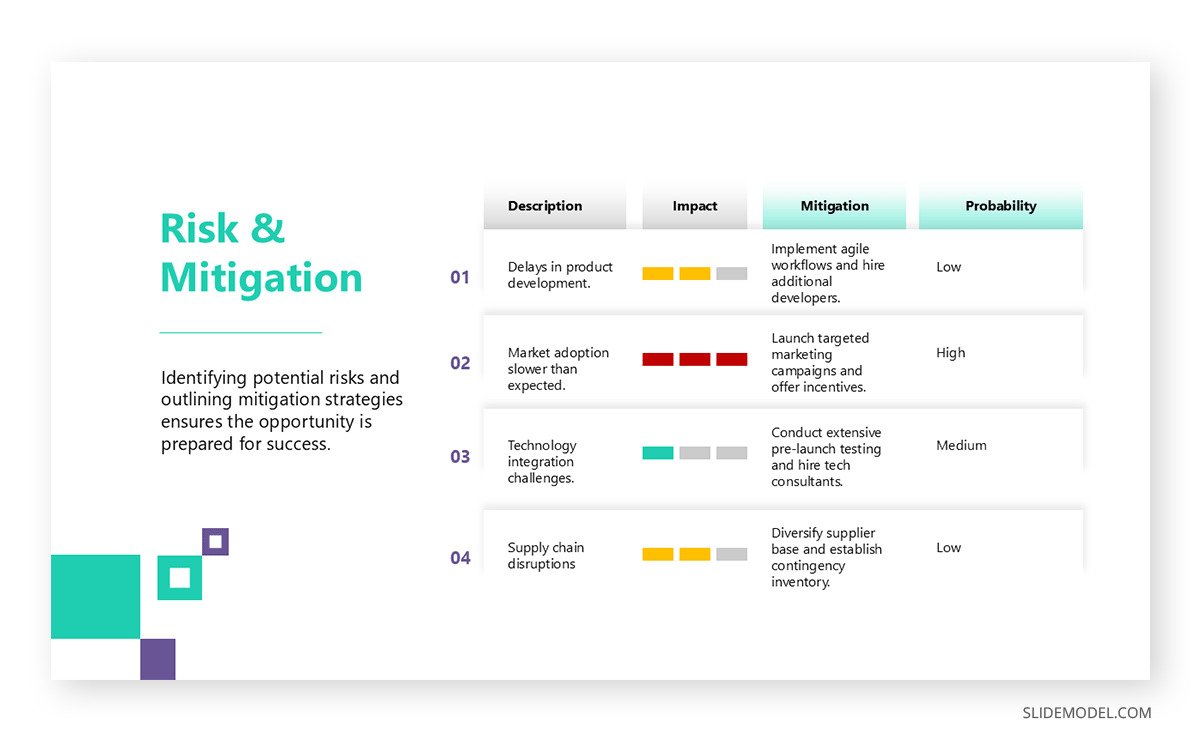
Risks should be categorized to ensure a comprehensive evaluation. These categories typically include market risks, operational risks, financial risks, and external risks. For example, in a procurement opportunity assessment, market risks might include price volatility or supplier shortages. In contrast, operational risks could involve delays in technology implementation or resistance to change within the organization. Each risk should be clearly defined, supported by data or examples, to illustrate its potential impact on the opportunity’s success.
Mitigation strategies are equally important in this section. For every identified risk, the presentation should propose measures to reduce or eliminate its likelihood or impact. Work with visual aids like risk matrices to provide a more efficient understanding of the terms exposed in this section. Check our article on risk analysis and risk management to better understand how to depict these points in your slide deck.
Implementation Plan
Now that all technical aspects are covered, it’s time to address the execution of the proposed solution. This section transforms the opportunity from a conceptual idea into a practical, actionable plan, giving stakeholders confidence in the organization’s ability to deliver results. It provides a step-by-step guide detailing timelines, milestones, resource allocation, and responsibilities, ensuring the opportunity can be brought to life effectively and efficiently.
A strong implementation plan begins with a clear timeline template. This timeline should divide the project into phases: development, testing, launch, and scaling. Each phase should include specific milestones to track progress and ensure accountability. For example, a procurement opportunity assessment might feature milestones like completing supplier negotiations, implementing procurement software, and achieving cost savings within the first quarter.
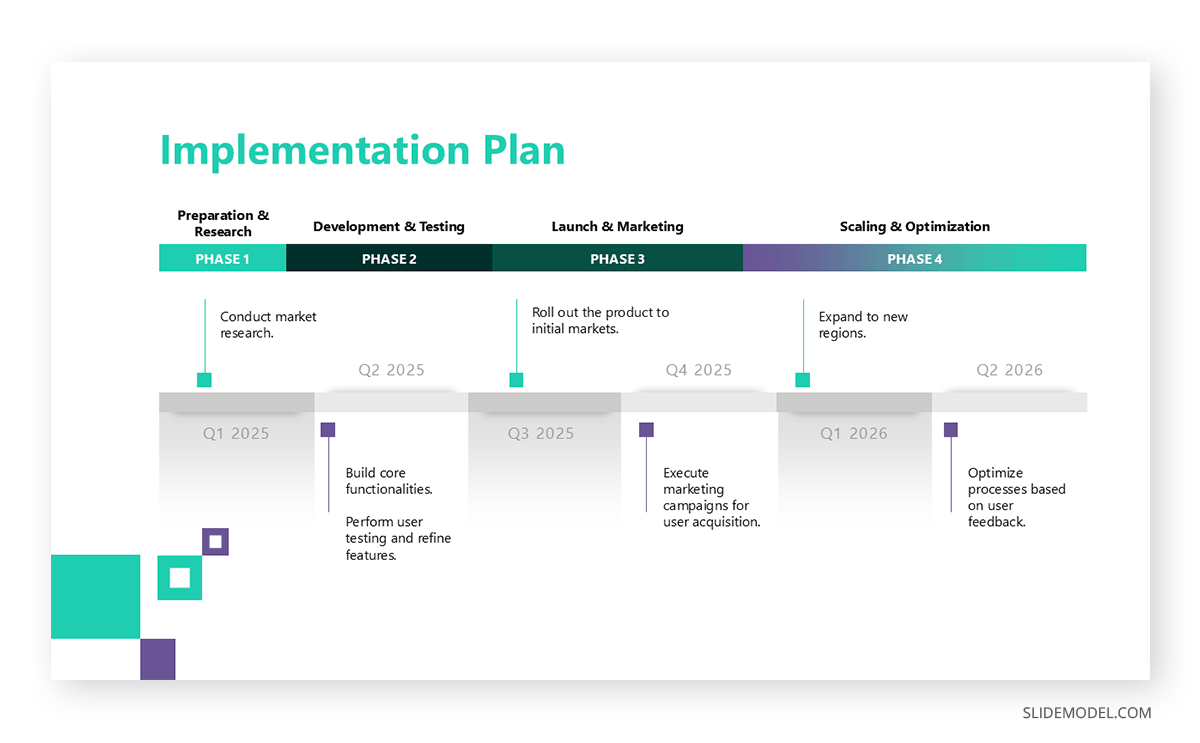
Risk management is a critical component of the implementation plan. Contingency plans for potential setbacks, such as delays or budget overruns, should be outlined to reassure stakeholders that the organization is prepared for unexpected challenges. Additionally, metrics for tracking progress, such as achieving specific deliverables within set deadlines, ensure the implementation plan is measurable.
Key Performance Indicators (KPIs)
Before dwelling on how to end a presentation, the final stage of this opportunity assessment is to present the metrics that will be used to measure the proposed solution’s success rate. This section is essential for ensuring accountability and transparency, as it defines how progress and outcomes will be evaluated throughout the implementation process and beyond. KPIs provide stakeholders with a clear understanding of success and how it will be quantified.
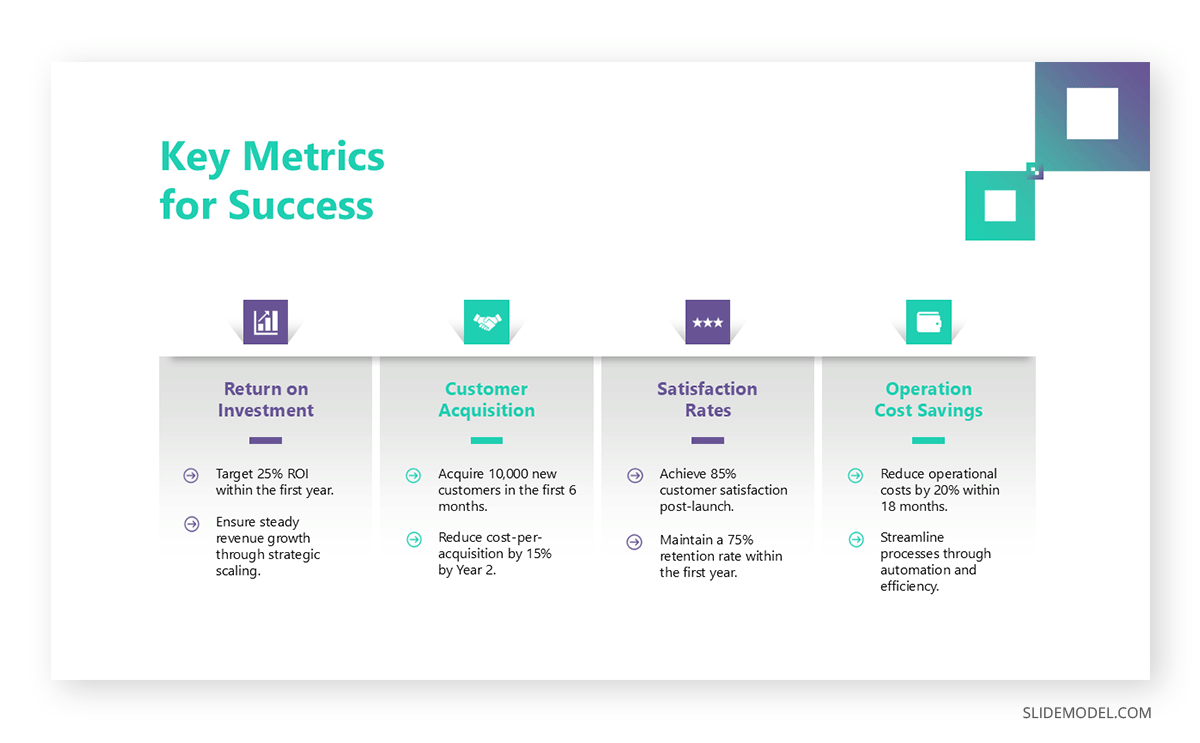
Effective KPIs are specific, measurable, achievable, relevant, and time-bound (SMART). For example, suppose the opportunity involves launching a new product. In that case, KPIs might include achieving $1 million in sales within the first six months, acquiring 10,000 new customers in the first quarter, or maintaining a customer retention rate of 85%. These metrics should align with the organization’s strategic goals and the opportunity’s value proposition.
Visual representations, such as dashboards or tables, can enhance this section by presenting KPIs in an easy-to-digest format. These visuals should also include baseline metrics to provide context for the proposed improvements.
Common Mistakes in Opportunity Assessment Presentations
Several common mistakes can undermine the effectiveness of an opportunity assessment presentation. Overloading the presentation with unnecessary data or jargon can overwhelm stakeholders, detracting from the key message. Similarly, failing to define the problem clearly or provide a compelling solution can weaken the presentation’s impact. Neglecting financial details, such as costs and revenue forecasts, leaves stakeholders without a clear picture of the opportunity’s feasibility.
Another common error is ignoring risks and mitigation strategies. A lack of transparency in addressing risks can make the opportunity seem unrealistic or overly optimistic. Weak competitor analysis or a poorly defined value proposition can damage the presentation’s credibility, as stakeholders may not see how the proposed solution stands out in the market.
Failure to include a procurement opportunity assessment in procurement-specific contexts may result in missed cost-saving opportunities or resource inefficiencies. Lastly, poorly designed slides or disorganized content can distract from the key points, reducing stakeholder engagement and comprehension.
FAQs
What is an opportunity assessment plan?
An opportunity assessment plan outlines the methodology and steps for evaluating a business opportunity, ensuring a systematic approach.
How is a procurement opportunity assessment different?
A procurement opportunity assessment optimizes procurement processes and identifies cost-saving opportunities within the supply chain.
What industries benefit most from an opportunity assessment?
Opportunity assessments are applicable across industries such as technology, healthcare, retail, manufacturing, and finance. Any sector that faces dynamic market conditions, evolving customer needs, or competitive challenges can benefit from systematically evaluating opportunities.
How does an opportunity assessment differ from a business plan?
An opportunity assessment focuses on evaluating the feasibility and potential of a single idea or initiative, while a business plan outlines the overall strategy and operations of an entire business. Opportunity assessments are often more concise and targeted.
Can an opportunity assessment be conducted for internal initiatives?
Yes, opportunity assessments can evaluate internal opportunities, such as improving operational efficiency, enhancing employee engagement, or reducing costs through new processes or tools.
How are competitors’ future strategies considered in an assessment?
Anticipating competitors’ future actions, such as product launches or pricing changes, is vital. Tools like scenario planning help evaluate how the opportunity could perform under different competitive scenarios.
How does sustainability factor into opportunity assessments?
Sustainability is increasingly important in opportunity assessments. Initiatives prioritizing environmental and social responsibility often resonate better with consumers and stakeholders.
Can opportunity assessments be used for partnerships or joint ventures?
Yes, opportunity assessments can evaluate the potential of partnerships or joint ventures by analyzing synergies, shared resources, and mutual benefits.
Recommended Opportunity Assessment PPT Templates
Check the following list of PowerPoint templates tailored to deliver high-quality pitches to stakeholders and guarantee the proposed solution’s success. All designs shown here also work as Google Slides templates.
